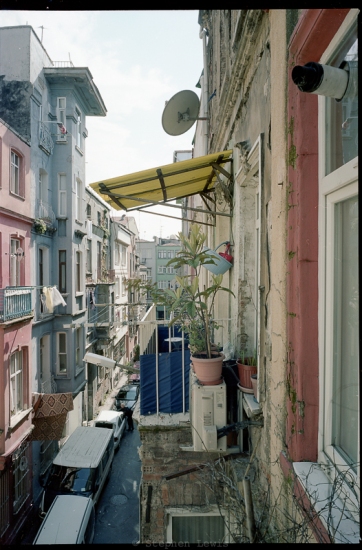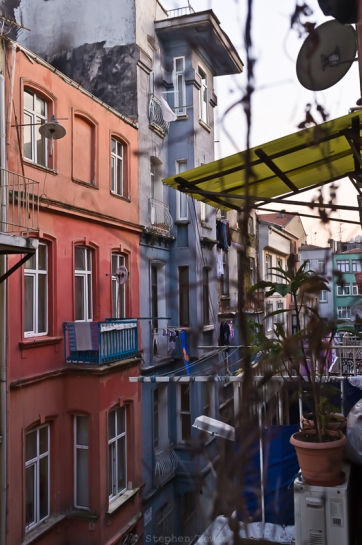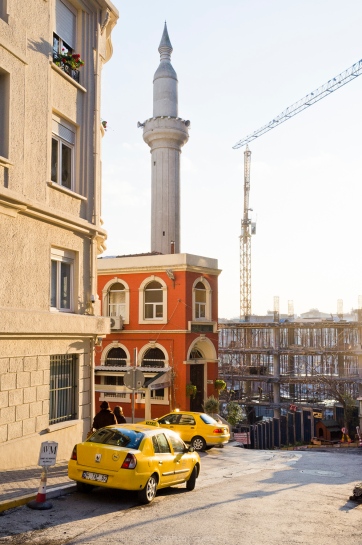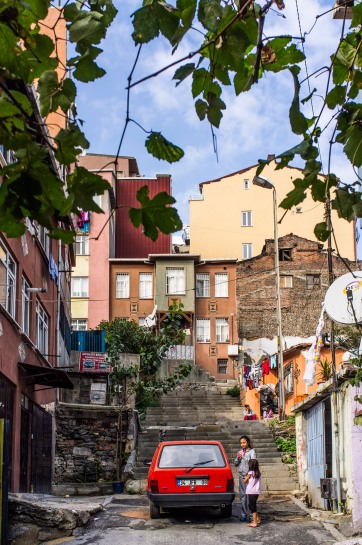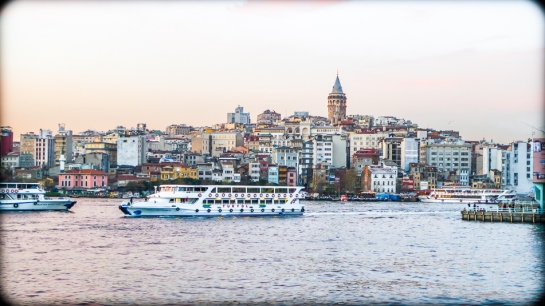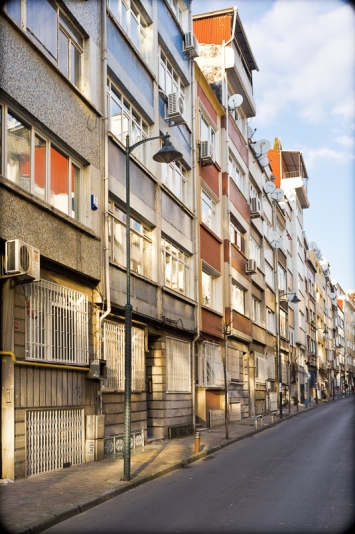 Two recollections of moments and details from spring-times past. Above: A kite, a delighted child, and a patch of green on the shore of the Golden Horn near Fener, Istanbul, 2012. In the background, a shipyard and dry-dock dating from early Ottoman times. Below: Blossoms, greenery, and the weathered, roughly-welded sheet-metal wall and numbered spaces of an empty parking lot in Sofia, Bulgaria, 2014 (the straightforward text on the signs: “paid unguarded” + “parking”).
Two recollections of moments and details from spring-times past. Above: A kite, a delighted child, and a patch of green on the shore of the Golden Horn near Fener, Istanbul, 2012. In the background, a shipyard and dry-dock dating from early Ottoman times. Below: Blossoms, greenery, and the weathered, roughly-welded sheet-metal wall and numbered spaces of an empty parking lot in Sofia, Bulgaria, 2014 (the straightforward text on the signs: “paid unguarded” + “parking”).
Istanbul
Recollections of Istanbul: One Balcony, Two Views, Two Media
Two views from a balcony on a cul-de-sac street in the Tepebaşı quarter of Istanbul, anno 2013. The buildings: Row houses built a century-and-a-quarter ago when the neighborhood was populated by Istanbul Greeks; the narrow frontages of the buildings dictated by late-19th-century regulations issued in the aftermath of fires that had swept gutted swaths of the city. Even day, these balconies continue to form an interstice between private and public space, serving as mini-terraces, extensions of domestic space, and perches for observing street life, chatting with neighbors, or just enjoying late day breezes.
The photo above was taken in 6X9 cm format on 120 color negative roll film through a 55mm Rodenstock lens (viewpoint equal to 24mm on 35mm film or “full-frame sensor” digital formats) mounted on a Toyo folding field camera. The photo below was taken with my customary APS-C format Fuji X100 digital camera (a “full-frame” equivalent of 35mm). The negative of the image at the top was scanned but, otherwise, not processed further. The sharpness and optical accuracy of the Rodenstock lens and the delicate colors of negative film stock are inimitable.
Meanderings Past: Two Random Street Corners, Istanbul
Street corners. Anchoring points in the urban landscape. Places to pause, linger, turn, or confront unexpected vistas. Apt metaphors for the start of a new year. Places devoid of meaning from the vantage points of automobiles.
Above and below: Two seemingly nondescript street corners in Istanbul, 2014.
At the top: An intersection in Gümüşsuyu near Taksim — a 1920s apartment house, a late-nineteenth-century neighborhood mosque, and a high-rise cube under construction. Straight ahead, a 45-degree plunge into the quarter of Fındıklı; a turn to the left, and a grid of steep side-streets and concrete stairways wending down to the Bosporus.
At the bottom: A hard-left-turn upwards past a rarely-used sidewalk, a recent generic apartment block, and the wall of a centuries-old cemetery at the edge of Hasköy on the Golden Horn, photographed late one Sunday afternoon at a moment when the roadway was free of its usual, near-continuous, high-speed stream of rattling bus, truck, and automobile traffic
Springtimes Past: Two Empires, Two Beverages, Two Distribution Systems
In the Kasım Paşa neighborhood of Istanbul, near to the shoreline of the Golden Horn: A simple çeşme (water fountain) flanked by a beverage dispenser so ubiquitous and recognizable that it requires no explanation.
The pattern of the relief on the marble face of the çeşme and the columns to the left and right of the inscription above it, lead me to the very amateur guess that the çeşme dates from the late-18th century. (The oddly perpendicular entablature appears to be a later impromptu addition or repair.) In a no less amateur way, I would date the Coca-Cola machine at the right of the image to the late-20th or early-21st century.
If memory serves me right, in one of his scores of publications, Halil İnalcık, a leading historian of the Ottoman period, famous both for his work and for having turned 100-years-old this year, once held that the provision of a comprehensive water supply and distribution system — from reservoirs to aqueducts to gravity-fed neighborhood outlets and fountains for ritual washing in the courtyards of the great Sultanic and smaller neighborhood mosques that dot Istanbul — was a defining feature of Sultan Suleiman the Lawgiver’s 16th-century project of reshaping the Ottoman capital as an “Islamic City.”
As to the development and worldwide availability and popularity of Coca-Cola: This is a long story in and of itself, best saved for treatment in a another context.
Springtimes Past: Istanbul, From Dolapdere to Kurtuluş
In the midst of unseasonably cold and gray weather, an image from a springtime past: greenery bursting forth from concrete, and laundry emerging from houses, along a backstreet and stairway on the rise from the valley of Dolapdere to the ridge-top neighborhood of Kurtuluş — long ago known by its Greek name, Tatavla, and once the realm people of modest means from Istanbul’s traditional “minorities:” Greeks, Armenians, and Jews. (The Greeks were forced out a half-century ago; many Armenians and some Jews remain.) The bay-windowed house in the center appears to be a surviving traditional-style Ottoman-era family residence subdivided into apartments and with its original wooden facade covered by layers of plaster. The children standing in the foreground and seated mid-distance are quite likely Kurds, recent arrivals to the backstreets of Kurtuluş from the east of Anatolia.
Spolia: From the Sublime to the Delightfully Utilitarian
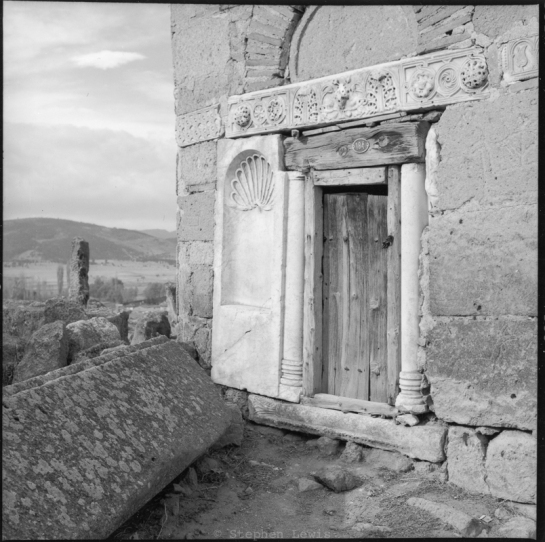
Spolia embedded in the facade of a Seljuk-era mausoleum, environs of Eskişehir, Turkey, 1997. Scan of print of b/w negative, Rolleiflex T Tessar f3.5. Click to enlarge.
Two examples of spolia, the re-use of architectural building and decorative elements outside of their original contexts. At its most basic, appropriation and utilization of spolia provided ready sources of materials and a seeming dedication to recycling. At a deeper level, however, use of spolia usurped and appropriated the might and worth of rulers, donors, and civilizations who originally built the monuments from which spolia elements were taken, and imbued new structures with added significance.
Hellenistic builders appropriated spolia from ancient monuments in Egypt and the near-east, Romans did the same, Byzantium appropriated spolia from Romans, Greeks, and their predecessors. The Ottoman empire, in turn, harvested spolia from Byzantium and its predecessors. In Istanbul, for example, free-standing obelisks and columns columns supporting the porticoes of great Sultanic mosques were taken from ancient temples and public buildings throughout the span of lands absorbed by the Ottomans.
Spolia at its most prosaic
The photos above and below portray the appropriation and application of spolia at the smallest of scales and at its most random and utilitarian. In the image above a pastiche of non-monumental classical elements adds a bit of decorative “pizazz” to the entrance way of an otherwise sparse Seljuk-era mausoleum. ( Whether the spolia elements were emplaced during the original construction of the mausoleum or after-the-fact is beyond my competence to assess.) In the image below, an inverted Byzantine capital is re-purposed to serve as the base for a garden-variety, hand-powered water-pump, itself re-purposed as a spout — an unintentional symbol of the triumph of the needs of small-scale basic craft over Byzantine grandeur (nb. the pump/capital ensemble is set in the courtyard of a Han designed nearly half a millennium ago by the great Ottoman architect Sinan, but occupied over the past century by the no-frills ateliers of independent metal workers). In both cases, the utility of spolia, and maybe even a drop of pride at its display, trumps any pretense of design.
Liberation from the terror of design
Subjectively, the (non-)aesthetic of such utility and pride in the display of the the recycled resonates deeply for me. Decades ago, I spent years living and working in the Netherlands, a country in which strict, linear, minimalist design ruled and constrained life in the public and private realms. Building facades, both legacy and new, were characterized by uniformity of height and materials and by an absolute minimum of decoration. In the field of graphic design, tiny type-faces and eschewal of serifs ensured that the covers and pages of Dutch publications were geometrically beautiful … but highly unreadable. For the Dutch, so it seemed, form trumped content and, as often as not, utility as well. During my years in the Netherlands, one of the leading design practices was an Amsterdam firm, Total Design, a name tastelessly similar to “total war,” Germany’s slogan in the final years of World War II for complete commitment of resources to the ruthless and murderous pursuit of victory — an apt, albeit tasteless, metaphor for the compulsory imposition of uniform aesthetic dictates on all aspects of life.
I find the seemingly arbitrary aesthetic of spolia far more compelling. The combination of random elements taken out of their original contexts transcends uniformity, negates original aesthetic and pragmatic dictates, generates spontaneity, and creates profound (and even humorous!) mergers, not only of materials, surfaces, and patterns, but also of times, spaces, cultures, and intents. In short, it enables continuous rearrangement and represents a triumph of accretion and serendipity of the imposition of design.
Multiple Faces of Istanbul: Mannequins, Metaphor, and Saturday’s Bomb Attack
The image above is from a series of photos treating mannequins in Istanbul, their manufacture and display, part of an in-depth look into the urban geography of a traditional sector. Mannequins, as I discovered, are designed and produced according to a complex web of typology and hierarchy — price-wise and according to the class, incomes, tastes, beliefs, cultures, and aspirations of the “markets” targeted to purchase the garments in which the mannequins will be clad. In a future entry, I hope to post more photos from the series and comment further.
Saturday’s bomb attack
For now, in light of the murderous bomb attack this past Saturday on Istanbul’s main pedestrian thoroughfare, Istiklal Caddesi, I am posting this photo as an all-too-obvious metaphor for the dualiities and contradictions that enrich but also plague Istanbul — its peace and its violence, its tolerance and its hatreds, its physical location straddling two continents, and its seeming temporal spanning of the world views of multiple centuries.
Metaphor
The black-white duality of the mannequins’ garb also suggests the extremes of Istanbul’s and Turkey’s ruling AK Party and its leader Recip Tayyip Erdogan — a propensity towards confrontation, bluster, and intimidation that yields and masks a polarized polity at home, failed ambitions in the middle east, failed outreaches towards the west, and dual failures in dealing with complex conundrums of Syria and predominantly Kurdish eastern Anatolia.
Black-white contrasts also characterize the history and transformation of Istiklal Caddesi and surroundings. In Ottoman centuries Istiklal was a street of palatial Ottoman homes and western embassies and, by the early- to mid- twentieth century, a western-style avenue of shops, cinemas and entertainment, with backstreets sheltering tenement housing and offering drink, music, and food, as well as bordellos, “straight” and transvestite.
In recent years, Istiklal continues to change, becoming less and less upscale on the one hand, and less local and bohemian on the other, and more and more like an open air shopping mall, with rising rents forcing out independent merchants and restaurateurs in favor of chain operations with deep pockets and with historic buildings gutted, their restored facades masking modern shopping emporiums. In the backstreets, “vice” and seediness fade and “cute” coffee shops take their place. The flow of pedestrians, locals and tourists, up and down Istiklal increases each year, with the noticeable changes that the crowds seem progressively younger and the tourists as often as not (mid-)eastern as western.
Even in the midst of such changes, Istiklal remains the site of political demonstrations and of symbolic acts, both democratic in aspiration, ala the summer of 2013 (scroll through the following group of posts) and, tragically, murderously anarchic as per Saturday.
The black-white metaphor also points to another of the city’s contradictions. Istanbul is marketed as “multicultural” and “tolerant,” but the reality plays out otherwise. Few Istanbul Greeks remain in the city, its Armenian population stagnates, and its Jewish population ages and declines year by year as younger Jews leave for abroad. What remain of all three of the city’s traditional minority populations have moved to the comfort, anonymity, and security of neighborhoods far afield from the surroundings of Istiklal.
Irony
By chance, three of the victims of Saturday’s bombing were Israelis and the attack took place within fifteen minute’s walk of the lower reaches of Istiklal, the neighborhood of Galata which, a century ago, had been home to a large Jewish population and that still houses three of Istanbul’s regularly-functioning synagogues. The three synagogues operate under extreme security, precisely due to eventualities such as Saturday’s attack — indeed, one of the synagogues was bombed fifteen years ago and attacked by machine gun and hand grenade wielding murderers fifteen years before that. Ironically, at the time of Saturday’s attack, the visiting Israelis would have been far safer attending one of the nearby synagogues than enjoying the sybaritic luxury of a peaceful Saturday morning stroll on Istiklal. This too is amongst the contradictions and ironies of Istanbul.
Reconsideration: Eye to Eye, Squint to Squint, and Thoughts on Who is Photographing Whom

Paint stall workers, Perşembe Pazarı (the Thursday Market), Galata, Istanbul, 2013; B/W negative; Rolleiflex Xenotar f2.8. Click on image to enlarge.
I have not posted to this site since mid-year 2015. Conceptually, long-form reading (for research and for its own sake) led me to push short-form writing to the side. On the visual side, malfunctioning of my supposedly trustworthy digital camera, the increasingly complex logistics of purchasing and processing film, and a search for new photographic approaches and subject matter caused me to reconsider the worth of my backlog of images and of the platforms I’ve used for sharing them. But now, for the moment at least, I’ve decided to pick up the thread …
The connection
The photo above provides continuity to my last post to this site. The photo was taken in the Perşembe Pazarı (Thursday Market) — the centuries-old (millennia-old, actually!) ships’ chandlers and metal-working market at the mouth of the Golden Horn, on the waterfront of the old Galata neighborhood of Istanbul — in one of the narrow streets just behind the buildings fronting the water at the left of the panaromic photo of the waterfront featured in my last post. The street in question contains the stalls and enclosed shops of paint merchants, competitors grouped one after the next as per the guild-like arrangements of traditional markets. The paint merchants test and display custom-mixed colors by dabbing pointillist brush strokes and Jackson-Pollack-like spray bursts onto exposed retaining walls in the increasing number of vacant lots that scar the neighborhood as developers race to position themselves for the windfalls of inevitable gentrification. (For a waterfront street-scape taken elsewhere in Perşembe Pazarı click here.)
Eyes to eyes, squints to squints
For years, I have shied away from candid photography, especially (per my lifelong contrived contrariness to fashions of the moment) the recent rage for “street photography.” To me, hidden cameras and surreptitious photographers can too easily cross the line into cowardliness, trickery, and exploitation. My take is (or maybe was) that achievement of direct eye-contact shows recognition and attentiveness on the part of the photographer towards the person-hood of the subject. Eye contact enables the subject to manifest him- or herself in a manner either inherent to themselves or to themselves as they wish to be at the moment. In short, it leads to willful collaboration of subject and photographer.
Objectivity or self-deception?
Recently, I’ve begun to question my stance. I ask myself how much the achievement of eye-contact and the seduction involved therein are true techniques of environmental portraiture versus how much they might engender projection, surrogate self-portraiture, and/or transcendence of loneliness on the part of the photographer. More abstractly, I wonder whether whether eye-contact is a means for capturing projection rather than subject? Or, more banal, how much the search for eye contact is a but a hangover from, and a nostalgia for, the family snapshots of my childhood?
As to what spurred my questioning … several things:
1. The suggestion of Austrian sociologist Marietta Mayrhofer-Deak, a collaborator on a proposed project, that I reread Photography and Sociology, a 1970s essay by Howard Becker, the octogenarian sociologist, one-time jazz musician, and innovator in participant research into “deviant” behaviors, beginning with one of the first detailed participant studies of marijuana-smokers!
2. A second suggestion from Marietta that I re-examine the detached and clinical, but nonetheless telling and powerfully moving, portraiture of August Sander (the full collection of which can seen on the website of the Museum of Modern Art in New York; and
3. My recent perusal of photos of a series of analogue photos of architectural details — balconies, doors, windows, caryatids, stairways — that I took in Sofia, Bulgaria during a winter of political upheaval and economic collapse nineteen years ago. How much, I now ask myself, did the Sofia series actually portray its inanimate subject matter? How much did my choice of subject matter, viewpoint, and framing actually represent the grim pessimism and insecurity of the society at the time? Or, how much were the photos expressions of my own inner state and preoccupations, independent of subject matter and context? Did the photos tell larger tales of the objects portrayed, their contexts, and the times, or merely express the narcissism or autism of me, the photographer?
More on this — and a sampling of photographs from the series referred to — in subsequent posts.
(Disclaimer: I have not worked or resided in Istanbul since January, 2015. Since then, I have only returned to Istanbul for a two-week stay during which I did not visit Perşembe Pazarı. Thus, I do not know how much of the market area has been razed since nor have I attended to my usual practice of trying to return to provide the subjects of photos with prints of their own, regardless of intervening time. Anyone more up-to-date on the present state of Perşembe Pazarı is welcome to comment)
Dusk on the Golden Horn: A Neglected Field Camera, a Pleasingly-Flawed Pocket Camera, and an Architectural Palimpsest
Neglected Field Camera
There is (or there used to be) a saying in Dutch that all that comes from afar is tastier (“Wat je veer vandaan halt is lekkerde” … or some-such). At first hearing, this might sound clever but its implications are unfortunate. Expecting greater satisfaction from afar can blind one to the satisfactions of all that is familiar and ready-to-hand. The scene portrayed in the photo above was a recurring vista along my routine trajectories during frequent stays in Istanbul over the last decades. Thus, in the spirit of the odd perspective of the Dutch saying, I neglected to photograph it with the attention it deserved. Many times, especially at dusk, when wending my way through crowds and passing by in a rush, I made notes to myself that I should return someday with a field camera, tripod, and roll or sheet film — reminders that I consistently ignored or postponed.
Pleasingly Flawed Pocket Camera
One late afternoon, however, I did happen to have a camera in my bag while walking by — a small-sensor, pocket-sized Panasonic LX3, a camera that by current standards and tastes should be retired to the shelf. However, despite its limitations and flaws — miniscule sensor with attendant poor light sensitivity, digital noise, smearing, lack of sharpness, etc. — on the rare occasions when I still take the LX3 with me I find it capable of surprisingly pleasing results, including the old-fashioned-picture-postcard-like “feel” of the photo above.
Architectural Palimpsest
The photo above portrays Galata from Eminönu, just at that time of day when the sky turns orange and pink and its colors are reflected on the silvery-blue surface of currents converging at the mouth of the Golden Horn. It shows Galata at its most monumental and most prosaic. At the top of the rise is the Galata Tower, a gargantuan remnant — rebuilt several times over the centuries and extensively remodeled during the 1960s — of former defensive walls and originally dating to pre-Ottoman Byzantium (1389) when Galata was a self-governing Genoese trading enclave.
Juxtaposed against the tower is the thin spire of the one-time British Sailors’ Hospital (1855). Just below and slightly to the left are the upper floors of the massive rear facade of a symmetrical dual structure originally built (1890) to house the headquarters of the Ottoman Bank and state tobacco monopoly. Designed to resemble an Ottoman-period wooden waterside mansion, the side of the building facing the Golden Horn and the hills of the old city of Istanbul on the opposite bank was conceived as counterweight of tradition to balance out the building’s self-consciously neoclassical and western-appearing street-side facade and main entrance-way.
Other buildings comprising the pointillist-like day-end physiognomy of Galata include late-19th- and early-20th-century commercial and residential structures and stark concrete structures built in the mid-20th-century on the footprints of past generations of buildings. At the water-side level are the warren of decrepit buildings, open spaces, and narrow streets comprising the Perşembe Pazar (Thursday Market), a ships’-chandler and metal-working market that has functioned since Byzantine times but that is now under threat of proposed redevelopment into an upscale tourist and “cool” restaurant, coffeehouse, and nightspot zone — necessary “progress,” perhaps, but “progress” that erases historical continuity, legacy trades, and economic functions that are tradition passageways to socio-economic mobility.
Afterword: Subjective Mapping
The photo also indicates places prominent in my own subjective mapping of Istanbul. It was on the bridge partially visible at the very far right of the photo that I was once involved in an accident that propelled me out of the world of work and income for a year but that also — despite surgery, pain, and other inconveniences — delivered me into an alternate world of reading, resting, exercising, and self-renewal. A miniscule protrusion slightly to the right of the Galata Tower appears to be the very tip of the pillow-like, orientalist-fantasy dome of the Ashkenazic Synagogue — opened in 1900 as the synagogue of the former Austro-Hungarian Jewish community of Istanbul and designed by architect Gabriel Tadeschi, also the architect of the Or-Ahayim Hospital in Balat — a place that I have visited on-and-off over the decade since my first work assignment in Istanbul in the late-1970s. Amongst the many worthy edifices — churches, office buildings, early apartment houses, synagogues, mosques, hans, and fountains — obscured by surrounding buildings and thus not visible in the photo is the late-19th-cenury neo-gothic Italian Synagogue, the Kal de los Frankos (Congregation of the Franks), where I enjoyed many pleasant Saturday mornings these past years and met a number of worthy friends and acquaintances .
Istanbul Architectural Miscellany: One Ridge, Two Valleys, Three Geographic Factors
Three photos of three structures linked by geography and revealing facets of the dynamics that have shaped Istanbul: The row of apartment houses shown above stands on the crest of a ridge; the church and the construction site portrayed in the images below are set in the deep valleys that wrap around its lower reaches.
Tatavla
The apartment house row is located in Tatavla (present-day Kurtuluş) near the quarter of Bomonti, neighborhoods once largely Greek and still, in part, populated by Armenians and Jews. Tatavla was redeveloped at the turn of the nineteenth to the twentieth century when “minorities” of modest income began to move out of cramped housing in the Galata and Pera and the slopes below them and resettle in newly built dwellings in the heights beyond Taksim. The uniformly narrow frontal widths of building plots were determined by fire laws of the time in combination the economics of low cost housing. Building facades have been refurbished over and again as the decades passed, creating a stark geometry of plasterwork and stone. The streets are as prim and as quiet as they are treeless.
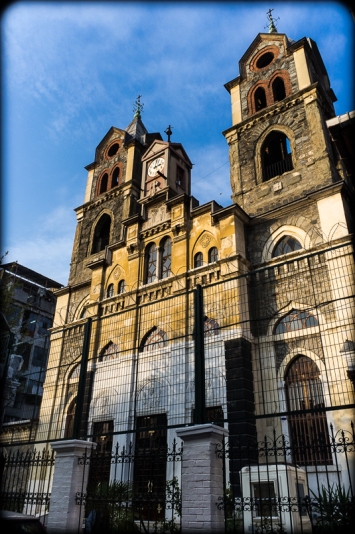
Facade, Evangalikos (Panagias Evangelista) Church, Dolapdere, Istanbul, 2012. Fuji X100. Click to enlarge.
Evangelikos
The church facade above is that of the Greek Orthodox Church of the Evangelikos (Panagia Evangelista), a huge eclectic structure combining a domed cruciform neo-Byzantine sanctuary with a neo-Gothic facade, a combination perhaps symbolic of the self-styled Byzantine roots and European aspirations of the community that built it nearly a century and a quarter ago. The Church of the Evangelikos stands in the valley of Dolapdere, one block from what is now a major traffic thoroughfare. Until recently, Dolapdere Boulevard was a rough and tumble street, by day home to automobile repair shops and ateliers producing window display mannequins and by night seemingly deserted and legendarily nefarious. Pedestrian traffic on Dolapdere is light but motor traffic is heavy and fast, and the church, half obscured by shabby storefronts fronting on the boulevard, is usually seen only in a mere flash from the windows of passing cars.
My guess is that the location of the Church of the Evangelikos was determined by two factors. First, like many Eastern Orthodox church locations, it was built adjacent to an ayazma, a sacred natural spring. Such streams have been holy to pagans and to Christians and to heterodox Muslims and dervishes as well, and have determined the sites of many other churches and one-time dervish monasteries throughout Istanbul. The second locational factor may have been more mundane but no less universal — cost. In inland parts of Istanbul, real estate prices traditionally are higher atop breezy crests and the upper reaches of slopes than in the less-well-ventilated, vista-less confines of valleys and former riverbeds .(Note: this rule is reversed at in the city’s coastal locations, where sea breezes and waterfront access and vistas have long commanded premium prices.)
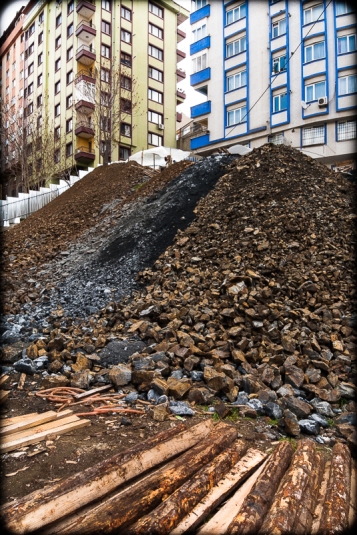
Construction site preparation, Bomonti / Piyale Paşa, Istanbul, 2013. Panasonic LX3. Click on image to enlarge.
Bomonti to Piyale Paşa below
The construction site pictured in the last of the three photos links back to a story I posted a year ago reflecting on development in Istanbul and the politics and values of hillside locations and views. At the time, the newly built middle-class dwellings in the upper reaches of the photo enjoyed views unobstructed by the shanty town below. In the present photo (taken in 2013), the shanty-town dwellings have vanished and site preparation materials for new blocks of flatsare laid out in artful cascading swirls. By 2014, the new flats were in place, leaving windows and balconies of the blue block shrouded in perpetual shadow, their views limited to the rear walls and windows of the newer buildings in front of them, from which they are now separated by a street of only medievally narrow width. In urban contexts, views and vistas are ephemeral and limited in time and reach, this is even more so the more modest one’s means and apartment.

